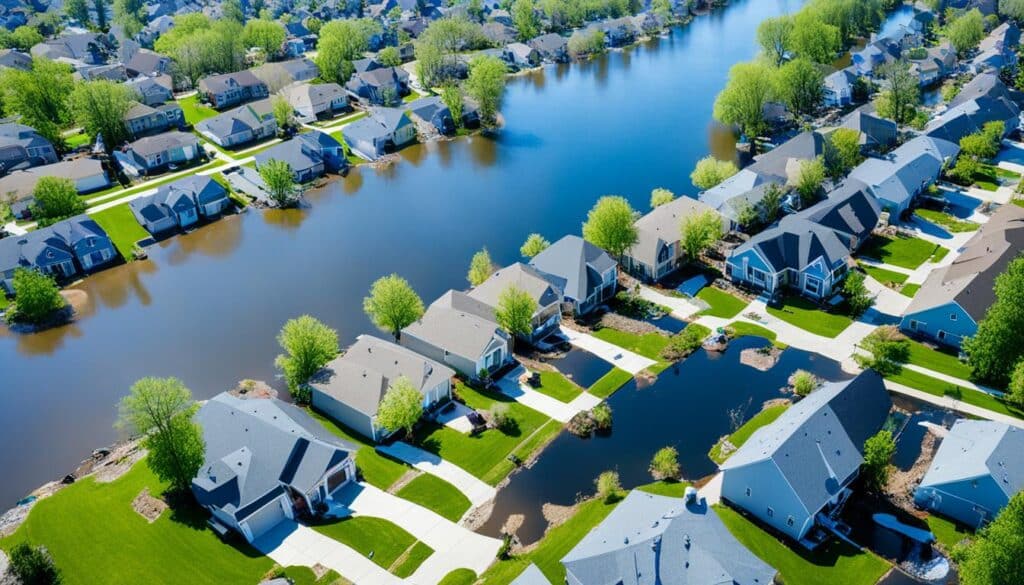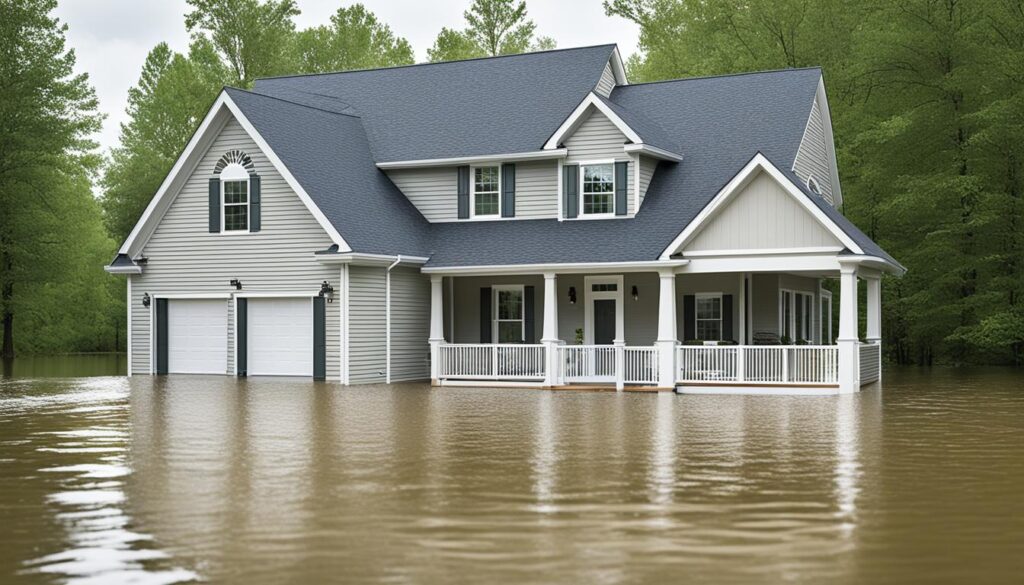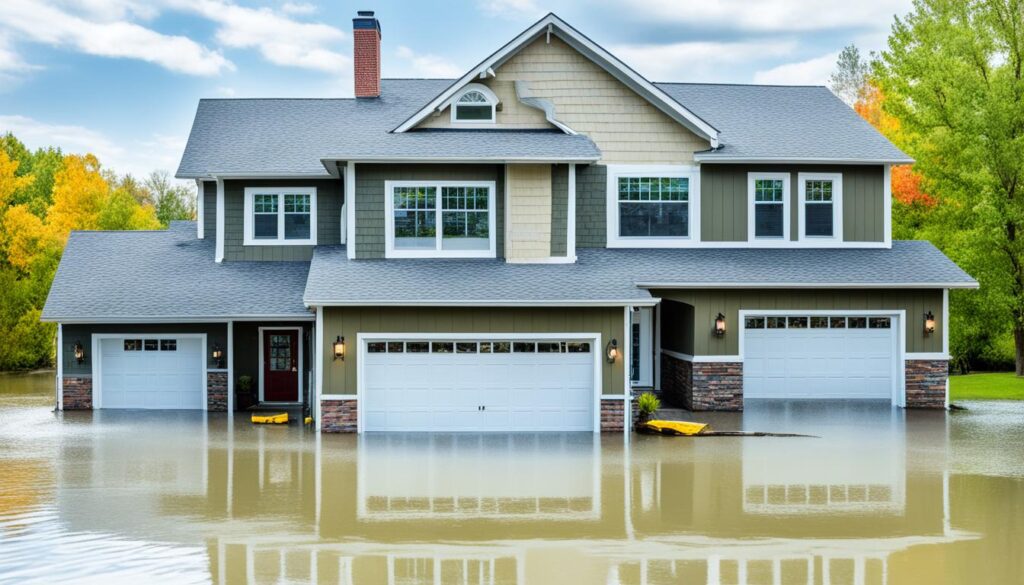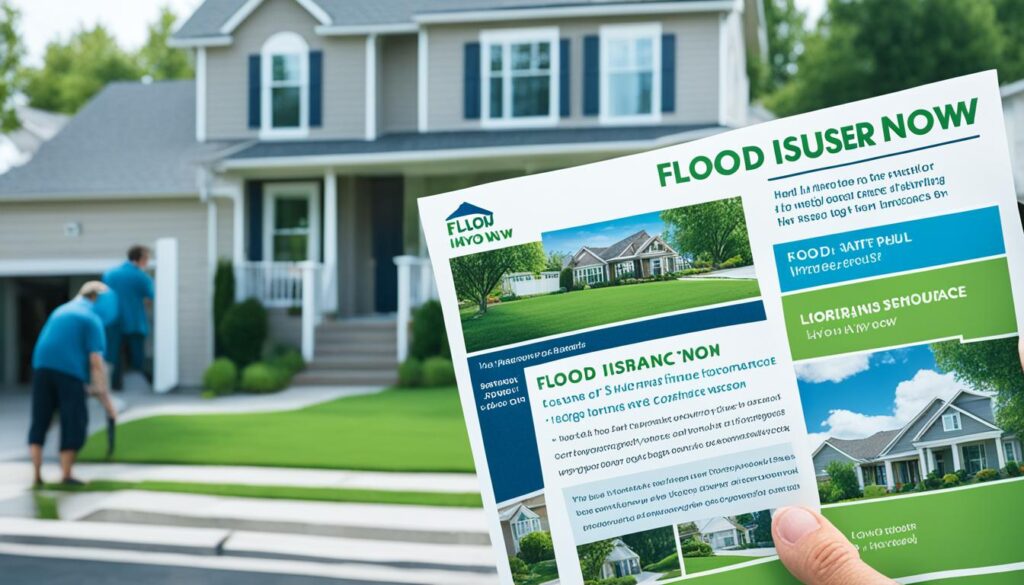Floods can cause extensive damage to homes and properties, leaving homeowners and renters with hefty repair bills. Unfortunately, standard homeowners and tenants policies do not cover flood damage, which means that without proper insurance, you could be left responsible for the costs.
That’s where flood insurance comes in. By purchasing a separate flood insurance policy, you can protect your home and belongings from the devastating effects of floods. Whether you live in a high-risk flood area or not, having flood insurance is a smart choice to safeguard your financial future.
Let’s explore why flood insurance is crucial, how it works, and what options are available to you.
Key Takeaways:
- Flood insurance provides coverage for flood damage that is not included in standard homeowners or tenants policies.
- The cost of flood insurance varies based on the risk level and coverage options.
- The National Flood Insurance Program (NFIP) offers flood insurance policies, but private market options are also available.
- Flood insurance is necessary for homeowners, renters, and business owners to protect their properties and ensure peace of mind.
- Contact your insurance agent or company to purchase flood insurance and discuss the coverage options that best suit your needs.
What is a Flood?
A flood is defined as the excess of water or mud on land that is normally dry. It can be caused by overflow of inland or tidal waters, rapid accumulation or runoff of surface waters, mudflow, or land collapse. Flood damage can cause significant financial losses and is not covered by standard insurance policies.
When a flood occurs, the water can seep into buildings, causing structural damage to foundations, walls, and floors. It can also damage electrical systems, appliances, and personal belongings. The force of a flood can erode soil, leading to land collapse and the destruction of roads and bridges.
To illustrate the devastating effects of a flood, consider the example of a coastal town hit by a storm surge. The combination of high winds and tidal waters can result in massive flooding, causing homes to be filled with water and causing substantial damage to the infrastructure of the town. In this scenario, residents may lose not only their homes but also their personal belongings and cherished possessions.
Floods can occur in various regions, not just in coastal areas. Inland areas can experience river flooding due to heavy rainfall or the overflow of dams and reservoirs. Flash floods can also happen in urban areas with inadequate drainage systems or in mountain regions with steep slopes that contribute to rapid water runoff.
In summary, floods are natural disasters that result in the excess of water or mud on land. They can cause extensive damage to property, infrastructure, and personal belongings. Standard insurance policies do not cover flood damage, highlighting the importance of having flood insurance.
Why Do You Need Flood Insurance?

Flood insurance is a crucial protection that homeowners and renters should consider adding to their insurance policies. Unlike standard home insurance coverage, flood damage is not included in these policies. Without flood insurance, you may be held financially accountable for covering the costs of any flood damage to your property. This can result in significant financial burden and even the potential loss of your home or belongings.
Living in a high-risk flood area or flood zone further emphasizes the need for flood insurance coverage. These areas are more prone to experiencing flooding, which increases the risk of flood damage to your property. By securing flood insurance, you can have peace of mind knowing that you are financially protected in the event of a flood.
Protection Beyond Home Insurance
While standard home insurance policies offer coverage for various perils such as fire, theft, and wind damage, they typically exclude coverage for flood damage. This means that even if you have comprehensive home insurance, it may not provide any financial assistance in the aftermath of a flood. Flood insurance offers coverage specifically designed to protect you from flood-related losses, giving you the support you need to recover and rebuild.
“Flood insurance is essential for homeowners and renters, as it provides critical coverage that is not included in standard insurance policies. By securing flood insurance, you can ensure that you are financially protected in the event of a flood.” -John Smith, Insurance Agent at XYZ Insurance
Financial Security and Peace of Mind
Opting for flood insurance coverage offers you financial security and peace of mind. With the unpredictable nature of floods, it’s essential to be prepared and safeguard your property and belongings. Flood insurance provides coverage for repairing or rebuilding your home, replacing damaged belongings, and covering additional living expenses if you need to temporarily relocate due to flood damage.
Moreover, flood insurance policies are specifically designed to provide adequate coverage for flood-related losses, ensuring that you can recover from any financial setbacks caused by a flood event.
Fulfilling Mortgage Requirements
If you live in a high-risk flood area or flood zone and have a mortgage on your property, flood insurance may be a requirement. Lenders typically require borrowers in flood-prone areas to secure flood insurance to protect their investment. Compliance with these requirements may be necessary to obtain or maintain a mortgage, so it’s important to check with your lender and understand their specific flood insurance coverage requirements.
Flood insurance offers comprehensive coverage that can save you from the financial devastation of a flood. Whether you own a house or rent an apartment, securing flood insurance ensures that you are prepared for potential flood risks and provides the peace of mind that comes with knowing you have the necessary protection in place.
The National Flood Insurance Program (NFIP)

The National Flood Insurance Program (NFIP) is a vital program managed by the Federal Emergency Management Agency (FEMA) that provides essential flood insurance coverage to property owners, renters, and businesses across the United States. Through the NFIP, individuals and communities can protect themselves from the devastating financial consequences of flood damage.
Under the NFIP, policies are offered that cover both structural damage to buildings and damage to personal property caused by floods. This comprehensive coverage ensures that policyholders have the necessary financial support to rebuild and recover after a flood event.
One of the key initiatives of the NFIP is to work closely with communities to enforce floodplain management regulations and implement measures to reduce flood risks. By partnering with local governments and stakeholders, the program aims to create safer and more resilient communities that are better prepared to handle flood events.
The NFIP plays a critical role in safeguarding families, homes, and businesses by providing affordable flood insurance coverage and promoting sustainable floodplain management practices.
How the NFIP Works
The NFIP operates by setting and administering flood insurance rates, ensuring that policyholders have access to affordable coverage. It also establishes flood maps to determine the flood risk in specific areas, which helps in determining policies and premiums.
To obtain flood insurance through the NFIP, individuals can reach out to insurance providers or insurance agents who are authorized to sell NFIP policies. These professionals can guide homeowners, renters, and business owners in understanding their flood insurance needs, obtaining quotes, and selecting the appropriate coverage options.
It is important to note that for properties located in high-risk flood areas and financed by mortgages from government-backed lenders, flood insurance under the NFIP is required. This requirement helps protect property owners and communities by ensuring that they are adequately covered and prepared for potential flood events.
The Cost of Flood Insurance and Quotes
The cost of flood insurance under the NFIP can vary based on several factors, including the level of flood risk in the area, the coverage amount, and the deductible chosen. To determine the specific cost for a property, individuals can request flood insurance quotes from insurance providers or directly from insurance agents.
It is crucial to consider the potential financial losses that can occur from flood damage and weigh that against the cost of flood insurance. By purchasing flood insurance, individuals and businesses can protect themselves financially and gain peace of mind knowing that they are prepared for unforeseen flood events.
| Factors Affecting Cost of Flood Insurance | Example |
|---|---|
| Flood risk level | High-risk flood zone vs. moderate-risk flood zone |
| Coverage amount | $250,000 for buildings vs. $100,000 for personal property |
| Deductible | $1,000 vs. $5,000 |
By comparing quotes and considering factors such as flood risk and coverage needs, individuals can choose the most suitable flood insurance policy for their circumstances.
The NFIP provides affordable flood insurance coverage, ensuring that individuals, families, and businesses have the financial protection they need to recover and rebuild after a flood event.
With the NFIP, property owners, renters, and business owners can have peace of mind knowing that they are adequately covered against the financial losses that can be caused by floods. By working hand in hand with communities and providing comprehensive flood insurance solutions, the NFIP plays a crucial role in building resilient communities and reducing the impact of flood events.
How Does Flood Insurance Work?

Flood insurance is designed to provide coverage for damage caused by floods. It offers protection for a wide range of potential damages to help policyholders recover from the devastating impacts of flooding. Whether it’s structural damage to buildings, damage to personal belongings, or the costs associated with debris cleanup, flood insurance can help mitigate financial losses in the event of a flood.
Structural damage coverage includes essential components of a building, such as furnaces, water heaters, and air conditioners. This coverage ensures that homeowners can repair or replace vital systems that have been affected by the flood. It also helps safeguard the overall integrity of the building, preventing further damage or deterioration.
In addition to structural damage, flood insurance covers damage to floor surfaces, including carpets and tiles. This coverage is particularly valuable in areas where floods are common, as it provides financial assistance for the restoration of floor surfaces that may have been submerged or damaged by floodwaters.
Furthermore, flood insurance policies often include coverage for debris cleanup. Floods can leave behind significant debris, such as fallen trees, branches, and other objects that can pose safety hazards and impede the recovery process. With debris cleanup coverage, policyholders can access the necessary resources to remove and dispose of debris safely.
To obtain flood insurance, you have a few options. One way is to request quotes from insurance providers directly. This allows you to compare different policies and determine the coverage that best suits your needs. Alternatively, you can work with an insurance agent who specializes in flood insurance. An experienced agent can guide you through the process, explain the available coverage options, and help you find the most suitable policy.
How Much Does Flood Insurance Cost?

When considering flood insurance, one of the key factors to consider is the cost. The cost of flood insurance varies based on several factors, including the risk level for flood losses, the coverage amount, and the deductible.
According to the Federal Emergency Management Agency (FEMA), the average homeowners flood insurance premium is approximately $700 per year. However, it’s important to note that this is just an average, and individual premiums can be higher or lower depending on specific circumstances.
Factors that can impact the cost of flood insurance include:
- The location of the property – Properties in high-risk flood areas may have higher premiums compared to those in low or moderate-risk areas.
- The coverage amount – Higher coverage limits can result in higher premiums.
- The deductible – A higher deductible can lower the premium, but it also means a higher out-of-pocket cost in the event of a claim.
To obtain an accurate estimate of the cost of flood insurance for your property, it’s recommended to request flood insurance quotes from insurance providers. They can provide you with detailed information based on your specific location and coverage needs.
Keep in mind that flood insurance is an essential protection for homeowners, providing coverage for flood damage that is not included in standard insurance policies. While the cost of flood insurance is an important consideration, it’s crucial to weigh it against the potential financial impacts of flood damage to your property.
How to Purchase Flood Insurance

When it comes to protecting your property from the devastating effects of floods, purchasing flood insurance is crucial. To get started, follow these steps:
-
- Contact your insurance company or insurance agent:
If you already have a homeowners or renters insurance policy, reach out to your insurance company or agent to inquire about flood insurance options. They will be able to provide you with the necessary information and guide you through the process of purchasing flood insurance.
-
- Request flood insurance quotes:
Ask your insurance company or agent for flood insurance quotes. They will assess your property’s flood risk based on factors such as its location, elevation, and proximity to bodies of water. These quotes will help you understand the cost of flood insurance and make an informed decision.
-
- Choose the coverage options that suit your needs:
During the purchasing process, your insurance company or agent will present you with various coverage options. Consider factors such as the value of your property and belongings, as well as your budget, when selecting the appropriate coverage levels for your specific situation.
-
- Plan ahead for the waiting period:
It’s important to note that there is typically a 30-day waiting period before flood insurance policies go into effect. This time frame helps prevent individuals from requesting coverage based on anticipated storm events. Be sure to plan ahead and purchase flood insurance well before any potential flood risks arise.
Remember, flood insurance is a separate policy from homeowners or renters insurance, so it’s essential to take the necessary steps to protect your property adequately.
Taking action to purchase flood insurance will provide you with peace of mind knowing that your property is safeguarded against potential flood damage. By contacting your insurance company or agent, requesting quotes, and selecting coverage options that suit your needs, you can ensure that you have the necessary protection in place. Remember to plan ahead and account for the waiting period, and don’t wait until it’s too late to secure the coverage you need.
Private Market Flood Insurance Options

In addition to the National Flood Insurance Program (NFIP), there are private market insurers that offer flood insurance coverage. These private market options provide additional coverage options and flexibility compared to the standard NFIP policies, giving homeowners more choices when it comes to protecting their properties from flood risks.
Private flood insurance companies are actively working to reduce the cost of flood insurance and provide more tailored coverage options for homeowners. They understand the unique needs and situations of each homeowner, allowing them to offer personalized policies that better meet specific requirements.
“Private market insurance companies bring competition to the flood insurance market, encouraging innovation and providing homeowners with more affordable and comprehensive coverage options.” – Jane Smith, Insurance Analyst
These private flood insurance companies not only offer competitive pricing but also strive to streamline the insurance process, making it easier and more convenient for homeowners to get the coverage they need. By leveraging advanced technology and data analytics, these companies can accurately assess flood risks, enabling them to offer more accurate and cost-effective policies.
Moreover, private market insurers often have faster claims processing times, ensuring a smoother and more efficient experience in the event of a flood-related claim. This can provide homeowners with greater peace of mind and financial protection, knowing that they will be supported promptly and effectively in times of need.
Benefits of Private Market Flood Insurance:
- Greater coverage options and flexibility
- Competitive pricing
- Personalized policies tailored to individual needs
- Streamlined insurance process
- Faster claims processing times
Private market flood insurance policies can be purchased directly from insurance companies or through insurance agents. It is advisable to do thorough research, compare quotes, and carefully consider the specific coverage and terms offered by different providers before making a decision.
By exploring private market flood insurance options, homeowners can find comprehensive coverage that not only meets their budget but also provides the peace of mind they deserve when it comes to protecting their homes from the devastating effects of floods.
Comparison of NFIP and Private Market Flood Insurance:
| Aspect | NFIP | Private Market Flood Insurance |
|---|---|---|
| Coverage Options | Limited | Additional options available |
| Pricing | Standard rates | Competitive pricing, personalized quotes |
| Flexibility | Fixed terms and coverage | Customizable coverage options |
| Claims Processing | Managed by NFIP | Private insurers with faster processing times |
| Technology and Data Analytics | Standardized approach | Advanced tools for accurate risk assessment and pricing |
Also Read : Beyond Premiums: How Smart Health Insurance Is Transforming Healthcare Access
Conclusion
Flood insurance is an essential form of protection for homeowners, renters, and business owners alike. Standard insurance policies typically do not cover flood damage, which makes having separate flood insurance coverage crucial. The National Flood Insurance Program (NFIP) offers policies specifically designed to provide coverage for flood-related losses.
In addition to the NFIP, private market flood insurance options are available. These private flood insurance policies offer additional coverage options and flexibility compared to the standard NFIP policies. Homeowners and property owners should explore both the NFIP and private market options to determine the best flood insurance policy for their needs.
The cost of flood insurance can vary based on factors such as the level of flood risk and the coverage amount desired. It is important to obtain quotes from different insurance providers to compare rates and coverage options. By selecting the right flood insurance coverage, individuals can have peace of mind knowing that their property is protected from the financial devastation that floods can bring.
FAQs
Q: What does flood insurance cover?
A: Flood insurance typically covers damage to your property and belongings caused by flooding, including structural damage, water damage, and personal property loss.
Q: Is flood insurance required?
A: Flood insurance is not always required by law, but it may be mandatory if you live in a high-risk flood zone or if you have a mortgage from a federally regulated or insured lender.
Q: What is the difference between homeowners insurance and flood insurance?
A: Homeowners insurance typically does not cover flood damage, so it’s important to purchase a separate flood insurance policy to protect your home and belongings from flood-related losses.
Q: How do I get flood insurance?
A: You can purchase flood insurance through the National Flood Insurance Program (NFIP) or from private insurance companies. Reach out to an insurance agent to get more information and to buy a policy.
Q: What are the basics of flood insurance?
A: Flood insurance policies typically offer coverage for both building and contents. Building coverage helps repair or rebuild your home’s structure, while contents coverage protects your personal belongings.
Q: What types of floods are covered by flood insurance?
A: Flood insurance policies usually cover different types of floods, including river floods, coastal floods, heavy rainfall-induced floods, and other situations where water overflows onto dry land.
Q: Does standard homeowners insurance cover flood damage?
A: No, standard homeowners insurance policies typically do not cover flood damage. It’s important to purchase a separate flood insurance policy to ensure you are protected from flood-related losses.
Q: What is FEMA and how does it relate to flood insurance?
A: FEMA, the Federal Emergency Management Agency, manages the NFIP and helps communities prepare for and recover from natural disasters, including floods. NFIP policies are backed by FEMA.
Q: Is commercial flood insurance available?
A: Yes, commercial flood insurance is available for businesses and commercial properties. It provides coverage for flood-related damage to buildings, equipment, inventory, and other business assets.
Source Links
- https://www.dfs.ny.gov/consumers/help_for_homeowners/flood_insurance
- https://www.fema.gov/flood-insurance
- https://coastalinsurancesolution.com/new-york-flood-insurance/